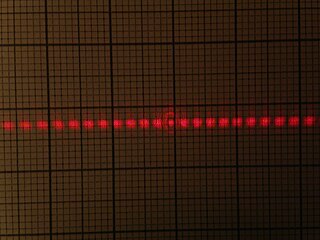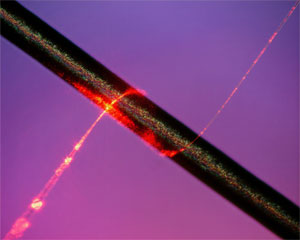
A photonic crystal is an optical nanostructure in which the refractive index changes periodically. This affects the propagation of light in the same way that the structure of natural crystals gives rise to X-ray diffraction and that the atomic lattices of semiconductors affect their conductivity of electrons. Photonic crystals occur in nature in the form of structural coloration and animal reflectors, and, as artificially produced, promise to be useful in a range of applications.

A metamaterial is any material engineered to have a property that is rarely observed in naturally occurring materials. They are made from assemblies of multiple elements fashioned from composite materials such as metals and plastics. These materials are usually arranged in repeating patterns, at scales that are smaller than the wavelengths of the phenomena they influence. Metamaterials derive their properties not from the properties of the base materials, but from their newly designed structures. Their precise shape, geometry, size, orientation and arrangement gives them their smart properties capable of manipulating electromagnetic waves: by blocking, absorbing, enhancing, or bending waves, to achieve benefits that go beyond what is possible with conventional materials.

An optical vortex is a zero of an optical field; a point of zero intensity. The term is also used to describe a beam of light that has such a zero in it. The study of these phenomena is known as singular optics.
Nanophotonics or nano-optics is the study of the behavior of light on the nanometer scale, and of the interaction of nanometer-scale objects with light. It is a branch of optics, optical engineering, electrical engineering, and nanotechnology. It often involves dielectric structures such as nanoantennas, or metallic components, which can transport and focus light via surface plasmon polaritons.

Extraordinary optical transmission (EOT) is the phenomenon of greatly enhanced transmission of light through a subwavelength aperture in an otherwise opaque metallic film which has been patterned with a regularly repeating periodic structure. Generally when light of a certain wavelength falls on a subwavelength aperture, it is diffracted isotropically in all directions evenly, with minimal far-field transmission. This is the understanding from classical aperture theory as described by Bethe. In EOT however, the regularly repeating structure enables much higher transmission efficiency to occur, up to several orders of magnitude greater than that predicted by classical aperture theory. It was first described in 1998.
A spaser or plasmonic laser is a type of laser which aims to confine light at a subwavelength scale far below Rayleigh's diffraction limit of light, by storing some of the light energy in electron oscillations called surface plasmon polaritons. The phenomenon was first described by David J. Bergman and Mark Stockman in 2003. The word spaser is an acronym for "surface plasmon amplification by stimulated emission of radiation". The first such devices were announced in 2009 by three groups: a 44-nanometer-diameter nanoparticle with a gold core surrounded by a dyed silica gain medium created by researchers from Purdue, Norfolk State and Cornell universities, a nanowire on a silver screen by a Berkeley group, and a semiconductor layer of 90 nm surrounded by silver pumped electrically by groups at the Eindhoven University of Technology and at Arizona State University. While the Purdue-Norfolk State-Cornell team demonstrated the confined plasmonic mode, the Berkeley team and the Eindhoven-Arizona State team demonstrated lasing in the so-called plasmonic gap mode. In 2018, a team from Northwestern University demonstrated a tunable nanolaser that can preserve its high mode quality by exploiting hybrid quadrupole plasmons as an optical feedback mechanism.

A subwavelength-diameter optical fibre is an optical fibre whose diameter is less than the wavelength of the light being propagated through it. An SDF usually consists of long thick parts at both ends, transition regions (tapers) where the fibre diameter gradually decreases down to the subwavelength value, and a subwavelength-diameter waist, which is the main acting part. Due to such a strong geometrical confinement, the guided electromagnetic field in an SDF is restricted to a single mode called fundamental.

A terahertz metamaterial is a class of composite metamaterials designed to interact at terahertz (THz) frequencies. The terahertz frequency range used in materials research is usually defined as 0.1 to 10 THz.

A photonic metamaterial (PM), also known as an optical metamaterial, is a type of electromagnetic metamaterial, that interacts with light, covering terahertz (THz), infrared (IR) or visible wavelengths. The materials employ a periodic, cellular structure.
A metamaterial absorber is a type of metamaterial intended to efficiently absorb electromagnetic radiation such as light. Furthermore, metamaterials are an advance in materials science. Hence, those metamaterials that are designed to be absorbers offer benefits over conventional absorbers such as further miniaturization, wider adaptability, and increased effectiveness. Intended applications for the metamaterial absorber include emitters, photodetectors, sensors, spatial light modulators, infrared camouflage, wireless communication, and use in solar photovoltaics and thermophotovoltaics.

A coherent perfect absorber (CPA), or anti-laser, is a device which absorbs coherent waves, such as coherent light waves, and converts them into some form of internal energy, e.g. heat or electrical energy. It is the time-reversed counterpart of a laser. Coherent perfect absorption allows control of waves with waves without a nonlinear medium. The concept was first published in the July 26, 2010, issue of Physical Review Letters, by a team at Yale University led by theorist A. Douglas Stone and experimental physicist Hui W. Cao. In the September 9, 2010, issue of Physical Review A, Stefano Longhi of Polytechnic University of Milan showed how to combine a laser and an anti-laser in a single device. In February 2011 the team at Yale built the first working anti-laser. It is a two-channel CPA device which absorbs two beams from the same laser, but only when the beams have the correct phases and amplitudes. The initial device absorbed 99.4 percent of all incoming light, but the team behind the invention believe it will be possible to achieve 99.999 percent. Originally implemented as a Fabry-Pérot cavity that is many wavelengths thick, the optical CPA operates at specific optical frequencies. In January 2012, thin-film CPA has been proposed by utilizing the achromatic dispersion of metal-like materials, exhibiting the unparalleled bandwidth and thin profile advantages. Shortly after, CPA was observed in various thin film materials, including photonic metamaterial, multi-layer graphene, single and multiple layers of chromium, as well as microwave metamaterial.
A flat lens is a lens whose flat shape allows it to provide distortion-free imaging, potentially with arbitrarily-large apertures. The term is also used to refer to other lenses that provide a negative index of refraction. Flat lenses require a refractive index close to −1 over a broad angular range. In recent years, flat lenses based on metasurfaces were also demonstrated.
A plasmonic metamaterial is a metamaterial that uses surface plasmons to achieve optical properties not seen in nature. Plasmons are produced from the interaction of light with metal-dielectric materials. Under specific conditions, the incident light couples with the surface plasmons to create self-sustaining, propagating electromagnetic waves known as surface plasmon polaritons (SPPs). Once launched, the SPPs ripple along the metal-dielectric interface. Compared with the incident light, the SPPs can be much shorter in wavelength.
Photonic molecules are a form of matter in which photons bind together to form "molecules". They were first predicted in 2007. Photonic molecules are formed when individual (massless) photons "interact with each other so strongly that they act as though they have mass". In an alternative definition, photons confined to two or more coupled optical cavities also reproduce the physics of interacting atomic energy levels, and have been termed as photonic molecules.
In physics, a high contrast grating is a single layer near-wavelength grating physical structure where the grating material has a large contrast in index of refraction with its surroundings. The term near-wavelength refers to the grating period, which has a value between one optical wavelength in the grating material and that in its surrounding materials.

Plasmonics or nanoplasmonics refers to the generation, detection, and manipulation of signals at optical frequencies along metal-dielectric interfaces in the nanometer scale. Inspired by photonics, plasmonics follows the trend of miniaturizing optical devices, and finds applications in sensing, microscopy, optical communications, and bio-photonics.
Photonic topological insulators are artificial electromagnetic materials that support topologically non-trivial, unidirectional states of light. Photonic topological phases are classical electromagnetic wave analogues of electronic topological phases studied in condensed matter physics. Similar to their electronic counterparts, they, can provide robust unidirectional channels for light propagation.
Spoof surface plasmons, also known as spoof surface plasmon polaritons and designer surface plasmons, are surface electromagnetic waves in microwave and terahertz regimes that propagate along planar interfaces with sign-changing permittivities. Spoof surface plasmons are a type of surface plasmon polariton, which ordinarily propagate along metal and dielectric interfaces in infrared and visible frequencies. Since surface plasmon polaritons cannot exist naturally in microwave and terahertz frequencies due to dispersion properties of metals, spoof surface plasmons necessitate the use of artificially-engineered metamaterials.
Milton Kerker was an American physical chemist and former professor at department of chemistry at Clarkson University. He is best known for his work on aerosol, interface and colloid science, as well as for pioneering surface-enhanced Raman spectroscopy. Kerker effect in optics is named after him.
In photonics, a meta-waveguide is a physical structures that guides electromagnetic waves with engineered functional subwavelength structures. Meta-waveguides are the result of combining the fields of metamaterials and metasurfaces into integrated optics. The design of the subwavelength architecture allows exotic waveguiding phenomena to be explored.








